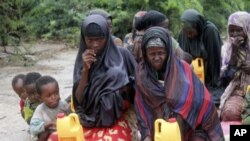In East Africa, droughts are occurring more frequently, putting millions of people at risk. But while not much can done to prevent droughts, more can be done to understand them and adapt to their effects.
Ocean temperature and dry air
Scientist Chris Funk said a drought is not simply due to a lack of rain over a long period, but also a greater demand on limited water resources by a growing population.
Funk is a research geographer with the U.S. Geological Survey and is on staff at California’s University of Santa Barbara Geography Department. He says droughts in East Africa have been occurring more frequently over the past 20 years.
Earlier this year, he co-wrote an article for Climate Dynamics that proposed a link between what happens in the Indian Ocean and what happens in East Africa.
“It really seems as if the warming of the central and southern Indian Ocean is contributing to more frequent droughts and intensification of the impacts of things like la Nina,” he said.
La Nina and El Nino are phenomena causing a rise or fall in ocean temperatures. Funk says the rise in temperature may seem small, but has a big effect.
“It’s warmed about a degree over the last 30 or 40 years and maybe about half a degree over the last 20. But the reason that it’s important is that it’s already really, really warm. And so, as far as we can tell, that warming has triggered more rainfall over the central Indian Ocean. And that rainfall basically pulls in moisture from the surrounding area and prevents it from going onshore into Africa,” he said.
Funk said, at the same time, that rainfall over the Indian Ocean is associated with hot stable air over parts of East Africa that reduces rainfall there.
“The sea surface temperatures in the Indian Ocean are really well correlated with global temperatures. So, the past 150 years, as far as we can tell, the Indian Ocean has gone up and down very closely with global temperatures. I’m not sure that we fully understand why that is, but it seems to be an area that as we’re experiencing global warming the Indian Ocean is warming up right in step with that,” he said.
Fueling those higher temperatures in the Indian Ocean is something called the Tropical Warm Pool, a concentration of very warm water. It’s located around Indonesia. Over the past 30 years, it has extended further and further.
Funk said that could mean more droughts, more often for parts of East Africa. However, it may also mean that some other areas may get greener.
“In central and eastern Kenya, it looks like the rainfall is decreasing. But as you go towards Lake Victoria, the rain there has remained steady. And so there’s a lot of opportunity for developing agricultural resources in the west that won’t be affected by climate change. And a similar situation exists in Ethiopia, comparing the north versus the south,” he said.
Areas where rains remain steady or actually increase could become breadbaskets for the region. Funk and others are working with USAID, the U.S. development agency, to make use of the rainfall patterns.
Funk said, “There are a lot of places and opportunities where you could raise crop yields substantially. And that would go a long way to relieving the problem.”
Funk and other scientists are part of FEWSNET, the Famine Early Warning Systems Network. FEWSNET issued a report a year ago warning that both short and long rains could fail. By May of this year, it was clear the situation had become very serious.
Some disagree
Not all agree with Funk and his colleagues that a rise in Indian Ocean temperatures means more droughts.
“For example,” he said, “if you look at the climate model simulations produced by the Intergovernmental Panel on Climate Change, they actually suggest that it’s going to get wetter in east Africa. Their projections are for 2080. So, they’re pretty far out.”
U.N. humanitarian officials estimate 11.6 million people need emergency assistance in the Horn of Africa. They say $2 billion is needed to pay for it. So far, $1 billion has been committed. Two parts of Somalia, Bakool and Lower Shabelle, are now facing famine.












